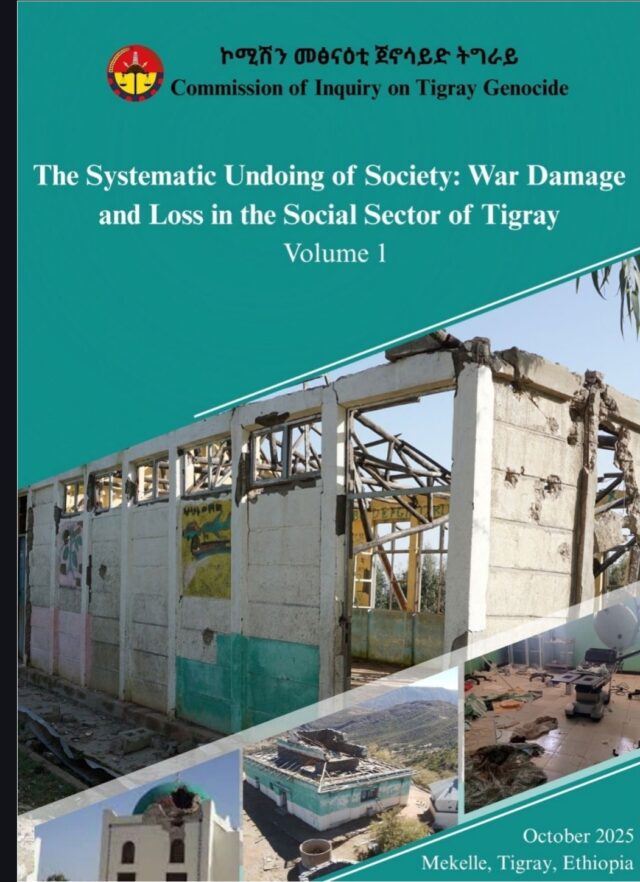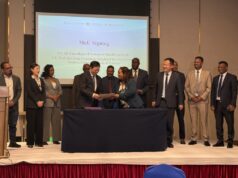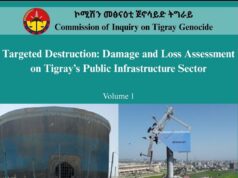Mekelle, October 29, 2025 (Tigray Mass Media Agency) — Commission of Inquiry on Tigray Genocide (CITG) has released volume 1 of its assessment report on War Damage and Loss in the Social Sector of Tigray, revealing that the war on Tigray has caused an estimated USD 10.86 billion in damages and losses across Tigray’s education, health, cultural heritage, and social welfare sectors.
According to the report, which is available on the commission’s official website https://citghub.org/, before the outbreak of war in November 2020, Tigray had been recognized for its remarkable social progress, including near-universal access to education and healthcare, gender parity, and strong traditional community systems which promoted solidarity and social resilience. However, the war and the two-year blockade shattered these gains, leaving Tigray in a deep humanitarian and socioeconomic crisis (CITG, 2025).
The CITG report explains that the assessment was conducted to document the extent and magnitude of damage across Tigray’s social sector and to provide evidence for justice, accountability, and recovery efforts. The report covered education, health, cultural heritage, religious institutions, and social welfare organizations, excluding Western Tigray and parts of the eastern and northwest Tigray. Using the UN-ECLAC Damage and Loss Assessment Framework and the UNESCO Damage and Risk Assessment Framework, data were collected from 659,675 households and 4,960 institutions, including health facilities, schools, cultural and religious centers, and social welfare organizations (CITG, 2025).
Findings from the CITG report show that the education sector suffered the greatest damage, amounting to USD 5.38 billion, followed by health at USD 3.59 billion, while cultural heritage and social welfare sectors recorded losses of about USD 1.88 billion combined.
The report identifies Eritrean Defense Forces, Ethiopian National Defense Force, Ethiopian federal police, Amhara and Afar forces, and Fano militia as perpetrators responsible for the destruction across Tigray’s social sectors. Based on the share of damage attributed to perpetrators, the Eritrean Defense Forces were identified as the main perpetrators, responsible for 56.3% of damage to education and 43.9% to health facilities. On top of the damage inflicted on education and health facilities, Ethiopian National Defense Forces and Amhara forces were also identified as major perpetrators responsible for 44.9 % in the destruction of social welfare organizations (CITG, 2025).
The report highlights that the war brought devastating consequences to Tigray’s human development. According to the report, in the education sector, over 1.2 million children were forced out of school, enrollment declined by more than 80 percent, and around 14,000 teachers and education officials did not return to their posts, worsening learning gaps and trauma among students. The report also shows that in the health sector, maternal mortality increased from 186 to 840 deaths per 100,000 live births, immunization coverage dropped from 100 percent to 20 percent, and only 30 percent of health facilities remain functional. Cases of chronic disease, HIV, malaria, and psycho-social trauma have all intensified (CITG, 2025).
The CITG report also documents the destruction of centuries-old heritage sites, historical artifacts, and religious properties. These losses have erased significant aspects of Tigray’s cultural identity and interrupted inter-generational cultural continuity. Traditional social systems such as Edir and Equb were destabilized, while forced identity changes and language suppression fractured community trust and weakened social cohesion (CITG, 2025).
The report indicates that the collapse of both public and private social services has deepened poverty, worsened displacement, and increased dependency on humanitarian aid. Restricted access to food, medicine, and education has further compounded the crisis (CITG 2025).
The CITG report concludes that the long-term effects of the war on Tigray require coordinated efforts among government institutions, communities, and development partners, calling for substantial investment and capacity-building to restore Tigray’s social systems and rebuild the collective resilience of its people.
For full access to the report and its findings, visit the Commission of Inquiry on Tigray Genocide (CITG) at https://citghub.org.
Home Uncategorized Commission of Inquiry on Tigray Genocide Assessment Report Reveals $10.86 Billion War-Time...








